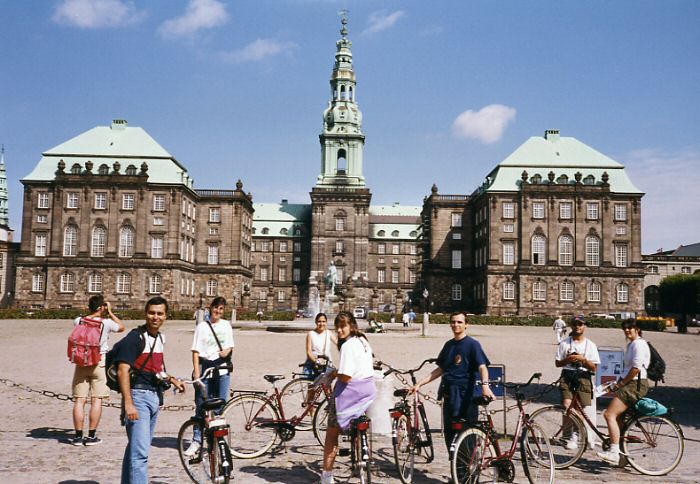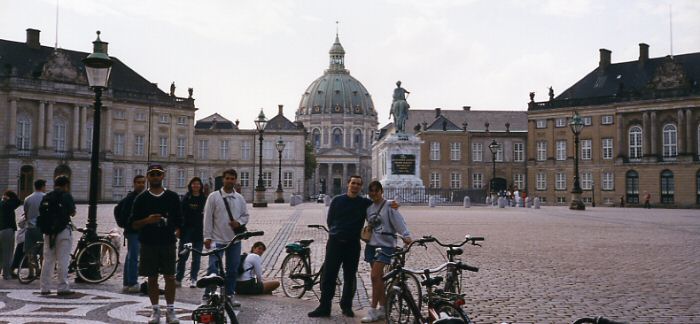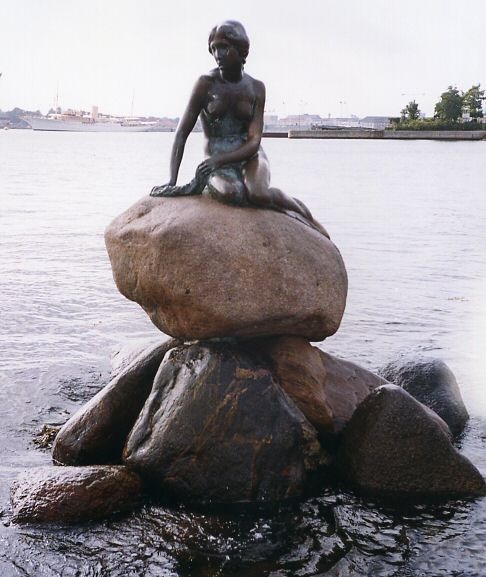Travel to Norway
Day 13 Copenhagen (100 Km.)
(in 100 Km.) Copenhagen (København): Today we visit the capital of Denmark. We rent bikes for travel the downtown, consisting of five pedestrian walks: Town Hall Square, Stock Exchange, the Royal Theatre, the harbor district of Nyhavn and the statue of "The Little Mermaid".
The City Hall is situated on Rådhuspladsen (City Hall Square). The appearance of the city hall is dominated by its impressive front, the golden statue of Absalon just above the balcony and the tall, slim tower with a clock. The city hall tower is at 105.6 metres. It was inspired by the city hall of Siena in Italy and their Construction began in 1892 and finished in 1905.

Copenhagen - Christiansborg Palace
Christiansborg Palace is the seat of the Folketing (the Danish parliament). The present building is the last in a series of succesive castles and palaces constructed in the same site since the erection of the first castle in 1167. Since 1794 served as the principal residence of the Danish kings and after 1849 as the seat of parliament. The palace now houses the Royal Reception Rooms, the Queen´s Library, the audience chambers, the Sovereign in Council rooms, the Chapel, Parliament, the Supreme Court and the Prime Minister´s Office.
Nyhavn is a colourful 17th century waterfront, canal and popular entertainment district. Stretching from Kongens Nytorv to the harbourfront just south of the Royal Playhouse, it is lined by brightly coloured 17th and early 18th century townhouses and numerous bars, cafés and restaurants. Serving as a heritage harbour, the canal is packed with old wooden ships.

Copenhagen - Nyhavn
Amalienborg Palace is the winter home of the Danish royal family. It consists of four identical classicizing palace façades with rococo interiors around an octagonal courtyard. In the center of the square is a monumental equestrian statue of King Frederik V. The four palaces surrounding the plaza were conceived of as town mansions for the families of chosen nobility. They were identical from the outside, but different on the inside. Building of the palaces on the western side of the square started in 1750 and were completed in 1760. The Danish Royal Life Guard (Den Kongelige Livgarde) march from Rosenborg Castle at 11.30 am daily through the streets of Copenhagen, and execute the changing of the guard in front of Amalienborg Palace at noon.
The Marble Church (Marmorkirken) or Frederik´s Church has the largest church dome in Scandinavia with a span of 31m. The dome rests on 12 columns. The inspiration was probably St. Peter´s Basilica in Rome. The foundation stone was set by king Frederick V on October 31, 1749, but was left incomplete and, in spite of several initiatives to complete it, stood as a ruin for nearly 150 years. Finally it was opened August 19, 1894. Due to disagreements between the architect and sculptor called to bring the statues that were to adorn the church, they made her too big to be housed in niches and so were placed outside.

Copenhagen - Amalienborg and The Marble Church
The statue of The Little Mermaid (Den lille havfrue) sits on a rock in the harbour at Langelinie park (where highligths the Gefion Fountain). This statue is a Copenhagen icon and a major tourist attraction. The relatively small size of the statue typically surprises tourists visiting for the first time. The Little Mermaid statue is only 1.25 metres high and weighs around 175 kg. The statue was commissioned in 1909 by Carl Jacobsen, who had been fascinated by a ballet about the fairytale of Hans Christian Andersen in Copenhagen´s Royal Theatre and asked the primaballerina, Ellen Price, to model for the statue. The sculptor Edvard Eriksen created the statue, which was unveiled on 23 August 1913. The statue´s head was modelled after Price, but as the ballerina did not agree to model in the nude, the sculptor´s wife Eline Eriksen was used for the body.
Between Amalienborg and the Little Mermaid you can find the Kastellet (The Frederikshavn Citadel), one of the best preserved fortifications in Northern Europe. It is constructed in the form of a pentagram with five bastions: The King´s Bastion, The Queen´s Bastion, The Earl´s Bastion, the Princess´s Bastion and the Prince´s Bastion. On the King´s Bastion, in the southwestern corner of Kastellet, stands a windmill, built in 1847. Kastellet´s construction was started by King Christian IV of Denmark as far back as 1626 with the building of an entrenchment in the northern part of the defense wall of Copenhagen.

Copenhagen - "The Little Mermaid"
Rundetårn (Round Tower) is a 17th century tower built as an astronomical observatory. It is most noted for its 7.5-turn helical corridor. leading to the top, and for the extensive views it affords over Copenhagen.
Tivoli is a famous amusement park and pleasure garden located right next to the Central Station. The park opened on August 15, 1843. From the very start, Tivoli included a variety of attractions: buildings in the exotic style of an imaginary Orient: a theatre, band stands, restaurants and cafés, flower gardens, and mechanical amusement rides such as a merry-go-round and a primitive scenic railway. After dark, coloured lamps illuminated the gardens.
Rosenborg Castle (Rosenborg Slot) is a renaissance castle situated in Kongens Have ("The King´s Garden"). The castle was originally built as a country summerhouse in 1606 and is an example of Christian IV´s many architectural projects. It was built in the Dutch Renaissance style, typical of Danish buildings during this period, and has been expanded several times, finally evolving into its present condition by the year 1624.